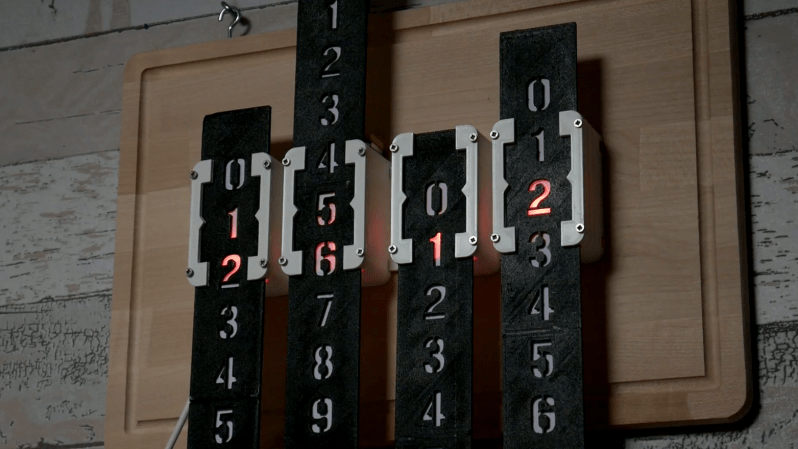We around the Hackaday shop never get tired of seeing new ways to mark the passage of time. Hackers come up with all manner of interesting timekeeping modalities using every imaginable material and method of moving the mechanism once per whatever minimum time unit the hacker chooses to mark.
But honestly, there are only so many ways to make a clock, and while we’re bound to see some repeats, it’s still nice to go over old ground with a fresh approach. Take this linear sliding stencil clock for instance. [Luuk Esselbrugge] has included some cool design elements that bear a closer look. The video below shows that the display is made up of four separate stepper motors, each driving a vertical stencil via a rack-and-pinion mechanism. There a simple microswitch for homing the display, and a Neopixel for lighting things up.
The video below shows that the stencils move very, very slowly; [Luuk] says that this is to keep the steppers as quiet as possible. Still, this means that some time changes take more than a minute to accomplish, which is a minor problem. The Neopixel also doesn’t quite light up just one digit, which should be a pretty easy fix for version 2. Still, even with these issues, we like the stately movements of this clock, and appreciate [Luuk]’s attempts to make it easier to live with.
Don’t let the number of clocks you see on these pages dissuade you from trying something new, or from putting your twist on an old design. Start with fridge magnets, an old oscilloscope, or even a bevy of steel balls, and let your imagination run wild. Just make sure to tell us all about it when you’re done.
[via r/Arduino]
















Cool, I’d like to see it done as a word clock.
Leds need to be up more. It makes the time look confusing.
Maybe build the LEDs into the sliders with contact points, when the slider is in the proper position the circuit is completed (you hope) and then you can light the LED.
You don’t need a switch. The micro controls the WS2812 LEDs and is driving the stepper, and knows exactly where the slider is.
Besides: That doesn’t solve the problem of the LED simply being in the wrong location.
Just connect data out from the last LED back to the micro, feed it 24 x (LEDs + 1) bits and you’re done, it automatically checks GND, VCC, (CLK) and data lines are properly connected. You can get rid of the switches, steppers and other rubbish and use coil gun and magnetic break to move those sliders then.
wtf is a “magnetic break”?
Uh, magnetic brakes have been in use for decades.
Ah. A typo. Not some magnetic detent or something. Got it.
But if by “magnetic brake” you mean the usual eddy-current brake, that only works to slow down moving objects: it will never bring a thing to a standstill, let alone hold it in position. Well, unless the thing is a superconductor.
I sort of agree. Having the LEDs on the slider would definitely make it brighter, and the satisfactory instant illumination of the circuit completing would be a nice touch. But like Paul said, just make the light brighter, change it’s placement and use the timer of the stepper.
A cool treadmill clock
It’s mesmerizing to watch it move, but I’m always frustrated when the video doesn’t make the time scaling obvious.
But now that I’ve thought about it some, I’m upset that the first strip has more than just 0/1/2, and the third strip only needs 0/1/2/3/4/5. It’s a clock, not a 0-9999 counter, right? :P
Yeah, that one got me too, it’s clock afterall. I always see some early optimizations and I learned it’s best not giving in to those impulses too fast. Once you get bored and start adding stuff (temperature, humidity, solar input, wind speed, …) you’re back to them big sliders. I might add some light guides to the box design immediatley though, was watching the video looking at that 2569, then 2610 thinking ???, … before realizing it’s going for 15:00
In the video, he shows it displaying temperature, in a different color. So yeah, useful for any numeric display.
I never get tired of seeing new ways to display the universal number set, time.
I went to watchmaking school 8 years ago with endless enthusiasm for a reason.
Wow that’s smooth.
So, when the umber rolls over you just disengage the stepper and let the slider fall under its own weight?
No. The stepper motors are bidirectional.
Another proof that time is linear and it’s all not a “wibbly wobbly timey wimey thing ” .
Aah, but no! It’s actually a clever demonstration reinforcing that continuous time is just an illusion to us. Instead of Planck time units that the universe is discretized in, this uses much larger stepper motor steps, but it still it looks continuous to our puny human Mk. 1 eyeballs.